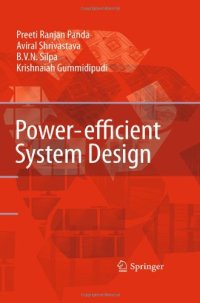
Ebook: Power-efficient System Design
- Tags: Circuits and Systems, Computer-Aided Engineering (CAD CAE) and Design
- Year: 2010
- Publisher: Springer US
- Edition: 1
- Language: English
- pdf
Power-efficient System Design Preeti Ranjan Panda Aviral Shrivastava B. V. N. Silpa Krishnaiah Gummidipudi This book addresses power optimization in modern electronic and computer systems. Several forces aligned in the past decade to drive contemporary computing in the direction of low power and energy-awareness: the mobile revolution took the world by storm; power budgets forced mainstream processor designers to abandon the quest for higher clock frequency; and large data centers with overwhelming power costs began to play vital roles in our daily lives. Power optimization was elevated to a first class design concern, forcing everyone from the process engineer, circuit designer, processor architect, software developer, system builder, and even data center maintainer to make conscious efforts to reduce power consumption using myriad techniques and tools. This book explores power optimization opportunities and their exploitation at various levels of abstraction. Fundamental power optimizations are covered at each level of abstraction and applied to components such as compilers, operating systems, servers, data centers, and graphics processors. This book covers a comprehensive range of disparate power optimizations and is designed to be accessible to students, researchers, and practitioners alike. • Low power digital design • Low power processor architecture • Power efficient memory and cache design • Power aware operating systems, compilers, and applications • Power issues in large servers and data centers • Low power graphics processors
This book addresses power optimization in modern electronic and computer systems. Several forces aligned in the past decade to drive contemporary computing in the direction of low power and energy-awareness: the mobile revolution took the world by storm; power budgets forced mainstream processor designers to abandon the quest for higher clock frequency; and large data centers with overwhelming power costs began to play vital roles in our daily lives. Power optimization was elevated to a first class design concern, forcing everyone from the process engineer, circuit designer, processor architect, software developer, system builder, and even data center maintainer to make conscious efforts to reduce power consumption using myriad techniques and tools. This book explores power optimization opportunities and their exploitation at various levels of abstraction. Fundamental power optimizations are covered at each level of abstraction, concluding in a case study illustrating the application of the major techniques to a graphics processor. This book covers a comprehensive range of disparate power optimizations and is designed to be accessible to students, researchers, and practitioners alike.